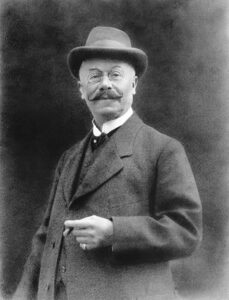
Emil Jellinek (April 6, 1852-Jan. 21, 1918) was born in Leipzig, Germany, to Rabbi Aaron Jellinek and his wife and rebbetzin, Rosalie Bettelheim. After moving to Vienna with his family, Jellinek dropped out of several schools and was fired as a clerk by the Moravian railway company, Rot-Koestelec North-Western. Through his father’s connections, he obtained positions in Austria’s diplomatic service, serving in Morocco, where he met his future wife Rachel Goggman. He and Rachel were married in Oran, Algeria, where their two sons, Adolph and Fernand, were born.
In 1884, he accepted a full-time position with the French Aigle insurance company, moving with his family to Baden bei Wien, where his daughter, Mercedes Jellinek, was born on Sept. 16, 1889. His insurance and stock trading business became successful, and the family spent winters in Nice, where eventually he was appointed as Austria’s consul. He also had an automobile dealership in Nice, which was profitable enough to enable Jellinek to commission automobile designer Wilhelm Maybach to design a race car according to Jellinek’s specifications. It had great success in automobile races, and its engine became known as the Daimler-Mercedes.
He obtained from Daimler Motoren Gesellschaft (DMG) the exclusive right to sell cars he called “Mercedes” in France, Austria, Hungary, Belgium and the United States of America.
In 1899, six years after his wife Rachel died, he married Madelaine Henriette Engler, with whom he would have four children, Alain, Guy, Rene and Andree. Jellinek took on the pseudonym of Monsieur Mercedes when he entered his cars in various races along the French Riviera.
The new Mercedes racecar was the consistent winner, resulting in increased popularity for the Mercedes line and reflected in the fact that DMG increased the number of its employees from 340 in 1900 to 2,200 in 1904. In 1902, the company decided to call all its cars Mercedes, registering the name on September 26, ten days after its namesake’s 13th birthday.
Jellinek thereafter changed his surname to Jellinek-Mercedes, commenting: “This is probably the first time that a father has taken his daughter’s name” From then on, he signed himself E.J. Mercedes. Meanwhile Jellinek also continued in Austria’s diplomatic service, taking posts in France, Mexico, and Monaco. In 1909, Mercedes ended most commercial activities but did purchase some casinos.
In 1914, when Austria entered World War I, his French and Austrian interests caused him to come under suspicion in both countries. He and his wife, nicknamed Anaise, moved to neutral Switzerland, where he was arrested temporarily, and where he died in 1918 at the age of 64.
As for the daughter for whom the car was named, she had an elaborate wedding in 1909 to Baron von Schlosser, and had two children with him, Elfriede and Hans-Peter. The family was made destitute by World War I. After their divorce, she married Baron Rudolf von Weigl, a sculptor, and together they eked out a living with his art and her singing. She was a soprano. She died in Vienna of bone cancer in 1929 and was buried in the family gravesite next to her grandfather, Rabbi Aaron Jellinek. Ironically, she cared little for cars, and never learned to drive.
Tomorrow, April 7: Haym Salomon
*
SDJW condensation of Wikipedia articles